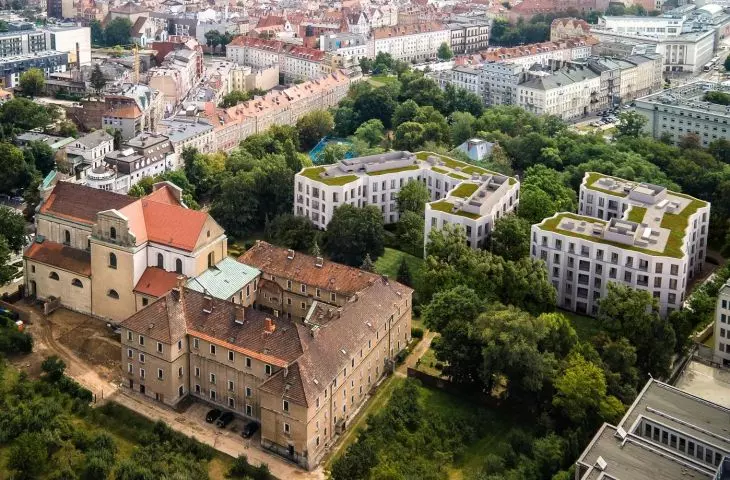We know the design for a very important site in the historic center of Poznań. Two residential buildings by designers from JEMS Architekci are to be erected on St. Adalbert's Hill. Although carefully integrated into the greenery, they will significantly affect this part of the city. Will they be beneficial? It's an area so complicated that we'll know the answer only after construction is completed.
St. Adalbert's Hill is a significant place: historically and spatially. Centuries ago an important dominant outside the walls of medieval Poznań. Today - an intimate enclave, hidden somewhat behind tenement buildings, on the edge of the strict Old Town. In the 1970s it was cut off from it by an unfortunate expressway (the string of Solna, Małe Garbary, Estkowskiego streets). Still, from several perspectives, the towering blocks of two churches are visible here: St. Adalbert's and St. Joseph's Basilica with the Monastery of the Discalced Carmelite Fathers. The latter complex, at the close of the downtown axis of Marcinkowskiego Avenue, is exposed in winter. In summer it disappears behind the foliage of the dense stand of trees with which the hill is overgrown on its southern slope.
It is on this hill, between the Jordan garden and the prosecutor's office building, among only partially preserved mature trees, that a residential enclave called "Solna 6" will be built, designed by JEMS Architekci for OKRE Development. This is another investment of this type in Poznań, after the "Perfumiarnia" by Wilson Park, from the respected Warsaw-based studio, which also has to its credit high-profile office and public projects: the Pixel complex (since 2012) and the new wing of the Raczynski Library (construction: 2013).
© OKRE Development
"Solna 6" is two buildings: a five-story and a four-story building. Their layout is subordinated to a row of century-old ash and oak trees. Both houses will accommodate 90 apartments, mostly large units (more than half of them measure from 77 to 94 sq. m., there are also over-metre-long apartments and a small number of apartments of more than 41 sq. m.). A distinctive feature of the simple lightly plastered blocks with half-open inner courtyards is the characteristic "pleated" facade, which - according to the designers' intention - is to link the residential interiors as strongly as possible with the greenery - found both on the investor's plot and in the neighboring garden at the back of the Carmelite monastery and church, which is inaccessible to Poznań residents.
© OKRE Development
The fact that the development will be one of the very expensive ones is evidenced not only by its location and generous square meters, but also by the height of the apartments (from 3 to almost 4 meters). In a nod to sustainable development, as well as to proven building traditions, the buildings' thick walls (almost 60 cm) are to be devoid of Styrofoam insulation and thin-coat plaster. Deep loggias, on the other hand, are to be a kind of space "drawn" into the perimeter of the apartment as a kind of extra room. What is important and rare nowadays, a significant part of the units are double-sided and ventilated. All windows are in the form of portfères, which are popular today and not always judiciously used. In this case, however, their use, surrounded by lush trees, seems justified.
© OKRE Development
This brings to an end speculation (though certainly not controversy) about the future of this very important part of the city. Preparations for the development of the land bought from the Church have been going on for a long time. As early as the 1990s, there were loud rumors about plans to build a luxury hotel on the site. Such a service, with exceptionally inappropriate access from Działowa Street, was allowed by the local zoning plan of 2006. Ten years later, the Carmelites applied for a change in the planning provisions to allow the construction of apartments on the site then owned by them.
A draft of the new plan was created at a rapid pace, by Poznań standards. Despite the favorable change in access (now from Solna Street), in 2018 members of the Municipal Urban Planning and Architectural Commission gave a critical opinion of the plan. They argued that "the proposed solutions do not allow for the formation of a high-quality downtown space in this area. The draft plan is only a record of the developer's guidelines (...)." The committee also criticized the road system, which interferes too much with the greenery, and the lack of comprehensive analysis of the impact of the development on the scenic axis from Marcinkowskiego Avenue.
It also alarmed that "the plan's provisions relating to the University of Arts site (on the south side of the developer's area) perpetuate and develop the current substandard development." The issue was that the possibility of closing the axis of the avenue with a volume referring to the Prussian commandant's office damaged in 1945 and demolished immediately after the war did not arise at Solna Street. After all, the southern slope was an extensive training ground for the German army in the 19th century (Cannon Square). Surrounded by greenery, the commandery occupied part of the area at the end of the same century.
However, the plan was approved without major amendments, in its imperfect version. Today we got to know the design of the residential development, which is in line with the plan, although, as Maciej Miłobędzki of JEMS Architekci points out in an interview with Gazeta Wyborcza, it does not make full use of the allowed development intensity. The designers also complimented the developer for its attention to greenery, emphasizing their efforts to highlight the course of the old avenue of trees. In care of it, the underground parking lot was divided into two parts to allow the growth of the mature specimens. Nevertheless, the cutting of trees for the project was accompanied by protests from the Old Town Estate Council. The investor reports that 35 trees were cut down, and the compensatory planting plan includes more than a hundred trees- mainly on the project site and in the neighborhood.
Unfortunately, it is difficult to determine how the development, located on the slope, which is taller and more massive than the houses on neighboring Działowa Street, will affect the view of the hill from Aleje Marcinkowskie. When questioned, the investor's representatives informed us that they do not have visualizations showing this. For a factual assessment, not without great concern, we must therefore wait until 2023 - the planned completion date of the investment.


































